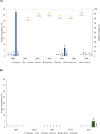Operational research to inform post-validation surveillance of lymphatic filariasis in Tonga study protocol: History of lymphatic filariasis elimination, rational, objectives, and design
- PMID: 39163407
- PMCID: PMC11335152
- DOI: 10.1371/journal.pone.0307331
Operational research to inform post-validation surveillance of lymphatic filariasis in Tonga study protocol: History of lymphatic filariasis elimination, rational, objectives, and design
Abstract
Background: Lymphatic filariasis (LF), a mosquito-borne helminth infection, is an important cause of chronic disability globally. The World Health Organization has validated eight Pacific Island countries as having eliminated lymphatic filariasis (LF) as a public health problem, but there are limited data to support an evidence-based approach to post-validation surveillance (PVS). Tonga was validated as having eliminated LF in 2017 but no surveillance has been conducted since 2015. This paper describes a protocol for an operational research project investigating different PVS methods in Tonga to provide an evidence base for national and regional PVS strategies.
Methods: Programmatic baseline surveys and Transmission Assessment Surveys conducted between 2000-2015 were reviewed to identify historically 'high-risk' and 'low-risk' schools and communities. 'High-risk' were those with LF antigen (Ag)-positive individuals recorded in more than one survey, whilst 'low-risk' were those with no recorded Ag-positives. The outcome measure for ongoing LF transmission will be Ag-positivity, diagnosed using Alere™ Filariasis Test Strips. A targeted study will be conducted in May-July 2024 including: (i) high and low-risk schools and communities, (ii) boarding schools, and (iii) patients attending a chronic-disease clinic. We estimate a total sample size of 2,010 participants.
Conclusions: Our methodology for targeted surveillance of suspected 'high-risk' populations using historical survey data can be adopted by countries when designing their PVS strategies. The results of this study will allow us to understand the current status of LF in Tonga and will be used to develop the next phase of activities.
Copyright: © 2024 Lawford et al. This is an open access article distributed under the terms of the Creative Commons Attribution License, which permits unrestricted use, distribution, and reproduction in any medium, provided the original author and source are credited.
Conflict of interest statement
The authors have declared that no competing interests exist.
Figures


Similar articles
-
Integrating post-validation surveillance of lymphatic filariasis with the WHO STEPwise approach to non-communicable disease risk factor surveillance in Niue, a study protocol.PLoS One. 2025 Jan 16;20(1):e0315625. doi: 10.1371/journal.pone.0315625. eCollection 2025. PLoS One. 2025. PMID: 39820223 Free PMC article.
-
Persistent lymphatic filariasis transmission seven years after validation of elimination as a public health problem: a cross-sectional study in Tonga.Lancet Reg Health West Pac. 2025 Mar 20;57:101513. doi: 10.1016/j.lanwpc.2025.101513. eCollection 2025 Apr. Lancet Reg Health West Pac. 2025. PMID: 40225853 Free PMC article.
-
Elimination of lymphatic filariasis as a public health problem in Malawi.PLoS Negl Trop Dis. 2024 Feb 16;18(2):e0011957. doi: 10.1371/journal.pntd.0011957. eCollection 2024 Feb. PLoS Negl Trop Dis. 2024. PMID: 38363794 Free PMC article.
-
Elimination of Lymphatic Filariasis in Shandong Province, China, 1957-2015.Vector Borne Zoonotic Dis. 2020 Dec;20(12):875-881. doi: 10.1089/vbz.2020.2624. Epub 2020 Aug 13. Vector Borne Zoonotic Dis. 2020. PMID: 32795160 Free PMC article. Review.
-
Elimination of lymphatic filariasis as a public health problem from the Arab Republic of Egypt.Acta Trop. 2019 Nov;199:105121. doi: 10.1016/j.actatropica.2019.105121. Epub 2019 Aug 7. Acta Trop. 2019. PMID: 31400299 Review.
Cited by
-
Perspectives on the implementation of post-validation surveillance for lymphatic filariasis in the Pacific Islands: A nominal group technique-based study protocol.PLoS One. 2024 Dec 2;19(12):e0313957. doi: 10.1371/journal.pone.0313957. eCollection 2024. PLoS One. 2024. PMID: 39621605 Free PMC article.
-
Integrating post-validation surveillance of lymphatic filariasis with the WHO STEPwise approach to non-communicable disease risk factor surveillance in Niue, a study protocol.PLoS One. 2025 Jan 16;20(1):e0315625. doi: 10.1371/journal.pone.0315625. eCollection 2025. PLoS One. 2025. PMID: 39820223 Free PMC article.
-
Persistent lymphatic filariasis transmission seven years after validation of elimination as a public health problem: a cross-sectional study in Tonga.Lancet Reg Health West Pac. 2025 Mar 20;57:101513. doi: 10.1016/j.lanwpc.2025.101513. eCollection 2025 Apr. Lancet Reg Health West Pac. 2025. PMID: 40225853 Free PMC article.
-
Reactive case detection can improve the efficiency of lymphatic filariasis surveillance compared to random sampling, Samoa 2023.PLoS Negl Trop Dis. 2025 Jul 11;19(7):e0012622. doi: 10.1371/journal.pntd.0012622. eCollection 2025 Jul. PLoS Negl Trop Dis. 2025. PMID: 40644410 Free PMC article.
References
-
- Riches N, Badia-Rius X, Mzilahowa T, Kelly-Hope LA. A systematic review of alternative surveillance approaches for lymphatic filariasis in low prevalence settings: Implications for post-validation settings. PLoS Negl Trop Dis. 2020;14(5):e0008289. doi: 10.1371/journal.pntd.0008289 - DOI - PMC - PubMed
-
- Sasa M. Human filariasis. A global survey of epidemiology and control: University Park Press.; 1976.
-
- Russell TLaB, T homas R. A guide to mosquitoes in the Pacific.: Pacific Community, Noumea.; 2023.
-
- Modi A, Gamit S, Jesalpura BS, Kurien G, Kosambiya JK. Reaching endpoints for lymphatic filariasis elimination- results from mass drug administration and nocturnal blood surveys, South Gujarat, India. PLOS Neglected Tropical Diseases. 2017;11(4):e0005476. doi: 10.1371/journal.pntd.0005476 - DOI - PMC - PubMed
MeSH terms
LinkOut - more resources
Full Text Sources
Research Materials

